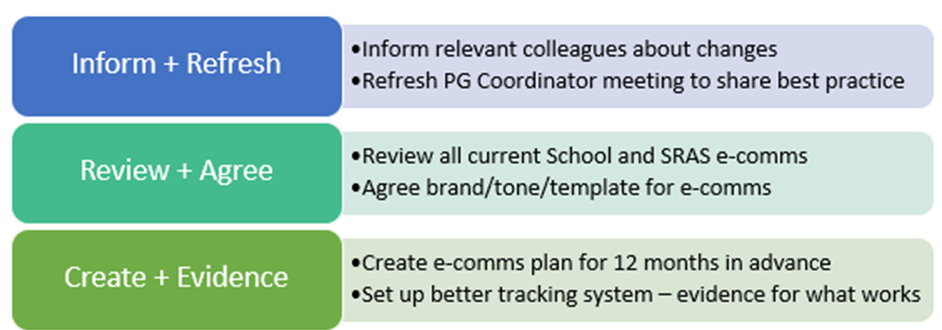E-communication is widely used for interacting with potential students to help them make an informed decision about their place of study. To ensure this method is delivering the desired experience, reviews of e-communication should take place to keep messaging fresh and relevant. In this blog Marion Malcolm of the University of Aberdeen discusses their project to review the E-communication to pre-registered students, with clear aims of ensuring the branding and student experience is consistent and that there is clarity in job roles with the overall goal of enhancing efficiency.
In May 2017, the Business Improvement (BI) team facilitated a project with the Student Recruitment and Admissions Services (SRAS), Marketing and Academic Schools to look at E-communication to pre-registered students. At that time e-communication was delivered via different teams, using different IT systems and using a variety of templates. This meant that pre-registered students could be receiving communication from different teams on the same day in inconsistent branding – leading to a confusing message being received. In addition, it was very difficult to have central reporting on the effectiveness of e-communications, as reporting relied on gathering information from different sources with manual manipulation of data.
The focus of the project was Postgraduate Taught (PGT) students, however e-communications with Undergraduate and Online Learning students were also kept in mind to ensure that the new way of working was able to flex to these markets. The aim was to give:
- Consistency of experience to enquirers and applicants to all schools
- Clarity on who does what across all teams
- Consistency of branding and content across e-communication
Approach
The BI Team used standard Lean methodology, tools and techniques to help the group identify the issues and reach a solution.
Day 1 was spent “AS IS” process mapping for the different sections. From that analysis, the group identified a number of Wastes (e.g. duplication and overlap) and Opportunities for Change (e.g. sharing content across SRAS, Marketing and schools). On Day 2 the group designed the “TO BE” process with the principles and products needed to implement a new system. As well as the master process, the group also designed a workflow for Schools to interact with Marketing and SRAS colleagues (with individual schools managing their own internal workflow for writing content).
Outcomes
The group agreed on a set of principles for the new process e.g.
- Enquiries and offer holder communications via a single CRM (SRAS already used Hobsons, so no additional costs or development needed) *
- E-communication to be set out every 2 weeks (1 x SRAS and 1 x school per month)
- Calls to action to be clear in messaging
- Ensure e-communications (e-zines) fit with other social media messaging
An action plan was put into place to:
Benefits from the change included freeing up staff time (less work and re-work) if staff can re-purpose content rather than starting from scratch every time; reducing single points of failure (for staff); ensuring that enquirers and offer holders get a clear UoA brand message and are not bombarded with messaging; and better analytics for what works.
Megan McFarlane (Enquiry and Conversion Manager, SRAS) was Project Lead and her thoughts are:
“It would be hard to overstate the improvements to the service we are now providing to our customers following this project. Moving to a centralised model, where School staff still get to provide content, but central communications staff use this to design attractive messages sent from one place, has led to huge benefits to the customer and the staff experience. Open and click through rates are tracked and used to improve future content, and there is a culture of continuous improvement in this area. Getting everyone in the room for two days and following Lean methodology has led us to this point, and from surveying the sector, it is clear we are now one of the leaders in this area”.
* The University of Aberdeen is moving to a MS Dynamics CRM from Summer 2018 onwards and the above project helped to embed standardised ways of working prior to the new IT platform being developed and implemented.









